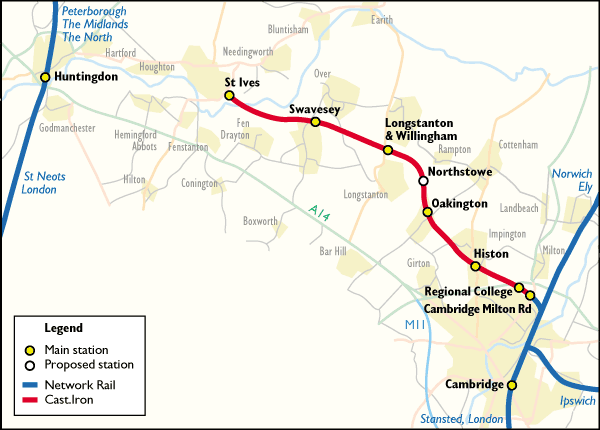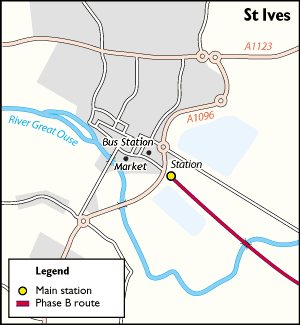|
|
| Home |
| About CAST.IRON |
| Our Plans |
| Story so Far |
| Opposition |
| Case for Rail |
| Milton Road station |
| In the News |
| Photo Archive |
| Contact Us |
Follow us on Twitter:
@CAST_IRON_INFO
Links:
NoGuidedBus.com
Travelling the Busway blog
Site maintained for archival purposesCAST.IRON - Stage 1B (Detail)Click here for summary plans for Stage 1B. 1. Service The Stage 1B rail service will operate from St Ives to Milton Road, connecting at Milton Road to Network Rail services, including electrified services to London. The Stage 1B service will run during weekday rush hour periods with a 15 minute service interval. It will also operate weekdays off-peak and all day Saturday with a 30-60 minute service interval. Passengers alighting at Milton Road will have access to the 10-minute bus service to the City Centre and Addenbrookes from the west end of the Science Park. It may be possible to arrange through-ticketing on these services; otherwise CAST.IRON will continue to run its own bus services into the City. CAST.IRON through trains may also be operated to Cambridge station. 2. TrainsA third train will be leased for Stage 1B, to the same specification as above. Two single carriage railcars will also be leased, to allow CAST.IRON to offer lighter loaded off-peak services at a minimum marginal cost. 3. St Ives Extension3.1. New Station and TrackThe route into St Ives will follow the old track bed as far as the bypass.  The station specification will be as for Stage 1A. The location of the station will be as shown on the map above. The land adjacent to the station can be used as a park and ride site, with road access via the current quarry road. A footbridge over the bypass will provide pedestrian access to the town centre. New 70mph track will be laid from Swavesey to St Ives. 3.2. Civil Engineering WorksReinstatement of the track to St Ives requires:
The former viaduct had two single track metal decks running over brick piers. Once deck remains as a heavy haul road. The second deck is missing and the brick piers are dilapidated. This structure is not suitable for reinstatement as a railway viaduct. A new structure, consisting of single track steel deck on concrete piers, will be constructed along the line of the missing deck. 3.3. Road CrossingsA new automatic half-barrier road crossing will be constructed at Swavesey. This will be operated using sensors on the track - when a train approaches the crossing, the half-barriers automatically operate and a white light then indicates to the driver that the barriers have been correctly lowered. Sensors on the other side of the crossing then cause the barriers to lift once the train has passed. At Swavesey, and at other crossings where there is a platform to one side of the crossing, special measures will be included to minimise the time for which the barriers are down. When a train approaches the crossing from the platform side, the barriers will be triggered not from a track sensor but from a driver's 'ready to proceed' button at the station. The driver will push the button while the train is standing in the station; as above a white light will then indicate when the barriers are down. Track sensors will cause the barriers to lift once the train has passed the crossing. The crossing will display notices to drivers of slow-moving vehicles to telephone the signalman for permission to cross, using the telephones provided at the crossing. (The signalman will be able remotely to stop the crossing closing and hence the white light from giving drivers 'clear to cross' while a slow vehicle crosses.) The four Stage 1A manual crossings will be upgraded to automatic half-barrier systems at Stage 1B. The crossing at Girton Road is not at a station, so that this upgrade will particularly improve the service speed, as drivers will not have to slow down. 3.4. Other CrossingsThe extension to St Ives is crossed by 10 footpaths, bridleways and vehicle tracks. Provision at footpaths and bridleways is as Stage 1A. The vehicle tracks are lightly used and therefore automatic open crossings will be provided at these points. These crossings have no barriers, but are otherwise as the half-barrier crossings described above. A sequence of amber and red flashing lights is activated by track sensors, with a white light to indicate to drivers that the light sequence has occurred. Telephone contact with the signalman is provided. 4. Milton Road Extension4.1. CAST.IRON Trackway70mph track will be laid as far as the west side of Milton Road. A new road crossing will be constructed to take CAST.IRON trains across the Regional College spur road. This will be a full barrier crossing, manually controlled remotely by the signalman. This type of crossing is required at roads liable to congestion and those whose proximity to a road junction carries the risk that traffic may back up on the crossing. As with automatic crossings, track sensors detect approaching trains. The signalman is notified of the approach and is provided with a CCTV view of the crossing. Subject to the crossing being clear, the signalman lowers the barriers and then a white light shows for the driver. There is a platform to one side of the crossing at the Regional College, so that a driver's 'ready to cross' button will be used to alert the signalman from that side. On the east side of the spur road there is a cycle/pedestrian crossing giving access to the Science Park. The flashing lights at the road crossing will be repeated at this crossing. CAST.IRON trains will terminate at the west side of Milton Road. Here two new platforms will be constructed, one for CAST.IRON trains and one for Network Rail trains. 4.2. Network Rail TrackwayA new 70mph track will be laid from Chesterton Junction to Milton Road station, running parallel to the CAST.IRON access track. This new Network Rail track spur will cross Milton Road to reach the new station. A full barrier crossing, as described above, will be constructed across Milton Road. The track circuits on the spur will be connected through to the Cambridge Signaling Centre, which will control access to the spur. The Network Rail spur will be overhead electrified, as the Cambridge main line, so that trains from London can run up to the Science Park (Trains on other routes, such as to Stansted, Norwich and Ipswich could also be extended to run up to the Science Park). 5. Dual Track SectionsIn order to operate three trains during peak periods, two sections of dual track will be constructed for Stage 1B. These will be on the sections from Histon to Oakington and from Longstanton to Swavesey. Each these dual track sections is more than 3km long. Dual track sections allow trains to pass at speed. They also prevent delays to one train from disrupting the whole timetable. Each direction on each dual track section will be signaled using an automatic two aspect signal, operated by the track circuits along the section. Each signal will prevent two trains from entering a section at once. The single track sections of the route will continue to be protected using section tokens, either physical or radio electronic tokens. 6. Through RunningIn parallel with the Network Rail spur, an access track between CAST.IRON and the national rail network will be provided. Special hand-over procedures will be defined to allow trains to be passed between the two operational domains, as occurs on other private railway systems. Once the CAST.IRON system has become operational, it will be possible to use the hand-over procedures between the two domains to run some CAST.IRON services through to Cambridge station. As noted previously, CAST.IRON trains will be operated by an established Train Operating Company, holding the necessary permissions to run on to the national network. Next - Stage 2 [summary] [detail] Site last modified January 2026
Tweet
|